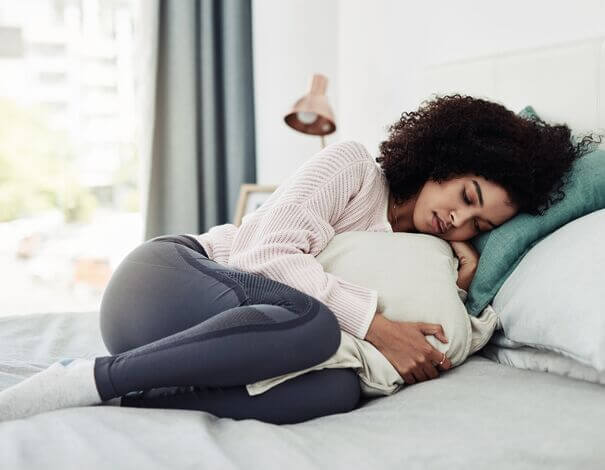Urinary incontinence
Urinary incontinence is a common disorder caused by many factors. It’s also a really embarrassing problem. Fortunately, there are ways to prevent the discomfort of urine leakage. Find out more about incontinence and how to treat it.What is urinary incontinence?
Urinary incontinence is the involuntary loss of urine in a sufficient amount that causes a hygiene problem and disrupts a person’s social life. Although more frequent in seniors, incontinence can also occur in younger people. No matter how old you are, incontinence can be embarrassing and must be treated.In some cases, incontinence can be resolved by correcting the cause (e.g., constipation). In other cases, treatment involves re-educating the bladder muscles and nerves or helping them work better through medication and pelvic floor muscle exercises.
Talking to your pharmacist is a key first step in managing incontinence.
Urinary incontinence causes
The most common causes of incontinence are:
- Constipation.
- Urinary tract infections, interstitial cystitis, bladder stones.
- Childbirth, menopause.
- Medications such as diuretics, sedatives and hypertension medications.
- Poorly controlled diabetes.
- Bladder or prostate cancer or second cancers from radiation therapy.
- Genitourinary surgery (such as a prostatectomy).
- Diseases such as Parkinson's disease, multiple sclerosis, stroke, Alzheimer's disease and dementia.
- Spinal cord injuries.
Types of incontinence
There are different types of incontinence that can appear alone or together.Urge incontinence
Urge incontinence, which is also called “overactive bladder” or “spastic bladder,” is when the bladder is very nervous and causes an urgent need to expel small amounts of urine many times during both the day and night. Diseases that damage the nerves, including Parkinson's and multiple sclerosis, are often responsible for this type of incontinence. Changes in posture, a rapid filling of the bladder (e.g., from alcohol intake) and urinary tract infections are also causes of this type of incontinence.Stress or effort incontinence
Stress or effort incontinence is when the muscle that keeps urine inside the bladder (the sphincter) and the muscles that support the bladder (the pelvic floor muscles) relax when pressure is put on the bladder. Laughing, sneezing, exercise and pregnancy are some of the factors that increase pressure on these muscles and let urine escape from the bladder. Physiological changes from menopause can also loosen the pelvic floor muscles.Overflow incontinence
This type of incontinence often occurs in men with an enlarged prostate, which puts pressure on the urethra ( the tube that empties the bladder). A compressed urethra prevents the bladder from emptying completely. Urine then frequently or continuously comes out, and urine flow is low. This type of incontinence often comes with the feeling that the bladder isn’t completely empty. Another phenomenon called hypotonic or neurogenic bladder can also cause this type of incontinence. In this case, the nerve connections to the bladder don't work properly. When the bladder is full, the pressure becomes so great that urine is then pushed outside.Functional incontinence
This type of incontinence occurs when you can’t get to the bathroom in time to urinate. This isn’t a problem with the bladder but rather an inability to urinate for various reasons, such as a physical or mental disability, or when the toilet is hard to get to in the home.
Incontinence treatments and medications
Bladder re-education
One way for people with urge incontinence to correct the problem is by creating a regular urination schedule. The goal is to re-educate the bladder, muscles and nerves as follows:
- Determine the shortest interval between your urges to urinate (e.g., 1 hour).
- For 1 week, urinate at this interval whether you need to go or not.If you don’t have any leaks during the first week, increase the interval by 30 minutes each week until you only feel the urge to urinate 5 to 8 times a day (the normal urination frequency) and you have no leaks.
Pelvic floor muscle exercises (Kegel exercises)
Several types of incontinence improve with Kegel exercises. These exercises strengthen the muscles that support the bladder to improve control and decrease or stop incontinence episodes. Kegel exercises involve tightening the muscles that prevent urination and then relaxing them. The full exercise regimen is as follows :
- Tighten your muscles for at least 10 seconds, and then release them for another 10 seconds. Repeat this sequence 10 times in a row, 3 times a day.
- Depending on your ability to do the exercises, each week your physiotherapist or doctor will increase the number of exercises that you need to do each day.
- You should have results after 6 weeks of doing the exercises.
- You’ll feel the maximum effect after 6 months. Since this is a “physical conditioning” of the bladder muscles, you need to keep exercising them to keep the benefits in the long term.
Devices that mimic normal bladder control
You can also use a device called a pessary, which keeps the bladder in place and reinforces loose pelvic floor muscles. A plug can also be inserted into the urethra to prevent urine leakage. However, these devices can cause urinary tract infections and inflammation of the vaginal mucus membranes in women. They are normally recommended by a urologist, who is a specialist of the urinary tract.
Medication
Before considering medication, your doctor and pharmacist must ensure that your incontinence isn’t a side effect of another medication or a disease that could be treated (e.g., constipation).
A number of drugs are effective at controlling incontinence. Each type of incontinence has its own specific drug treatment, and health care professionals can help you determine the cause of your incontinence and choose the most appropriate treatment for you.
Medications have different mechanisms of action. Some act on benign prostate hypertrophy in men, while others reinforce the bladder muscles or help to completely empty the bladder. You will feel the maximum effect of the medication 4 to 8 weeks after starting treatment.
As with any drug treatment, these medications may have side effects and interactions. Ask your pharmacist for advice.
Complementary treatments (physiotherapy)
- Vaginal weights, such as vaginal exercise cones (LadySystem™), can increase the strength of the pelvic floor muscles.
- Electrical stimulation applied directly to the pelvic floor muscles can help produce effective contractions.
- Biofeedback is a technique that uses a machine to measure pelvic floor muscle activity. This gives you a better idea of the strength and duration of your pelvic floor contractions.
- Surgery should be considered only when all other options have failed.
Tips and advice
Incontinence pants or underwear will let you avoid embarrassing incidents as you find the right treatment. Many products at the pharmacy will also help you avoid or discreetly manage accidents. Your pharmacist can help you choose the best product for your comfort and your type of incontinence.
You can also maintain your bladder health and prevent urinary incontinence by:
- Maintaining a healthy weight.
- Avoiding products that increase the urge to urinate, such as coffee, tea, herbal tea and alcohol.
- Drinking plenty of water (6 to 8 glasses) and eating enough fibre to avoid constipation.
- Limiting your intake of fluids after 5:00 p.m. and not drinking after 7:00 p.m.
- Getting regular exercise (30 minutes at least 5 times a week).
- Urinating when you have the urge and not holding it in.
If you have incontinence, don’t hesitate to talk about it with a health care professional. Incontinence can be treated, and you can live with this condition while keeping your dignity and quality of life.
The pharmacy services presented in this section are offered by pharmacist owners who are affiliated with Uniprix. The pharmacists are solely responsible for the professional activities carried out during the practice of pharmacy. These services are offered in participating pharmacies only. Certain fees and conditions may apply.
* The information contained herein is provided for informational purposes only and is not intended to provide complete information on the subject matter or to replace the advice of a health professional. This information does not constitute medical consultation, diagnosis or opinion and should not be interpreted as such. Please consult your health care provider if you have any questions about your health, medications or treatment.




